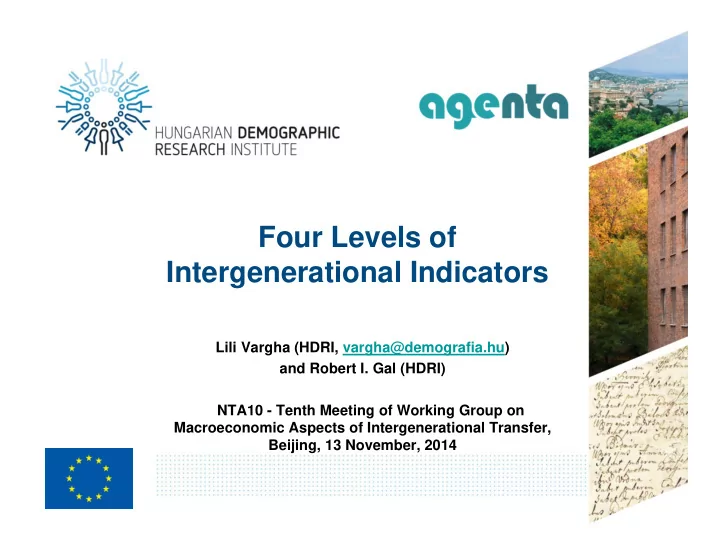

Four Levels of Intergenerational Indicators Lili Vargha (HDRI, vargha@demografia.hu) and Robert I. Gal (HDRI) NTA10 - Tenth Meeting of Working Group on Macroeconomic Aspects of Intergenerational Transfer, Beijing, 13 November, 2014
The four levels • Different flows of intergenerational transfers representing different systems of reallocation • 1. Public Pension System • 2. Public Programs • 3. National Economy • 4. Total Economy = National Economy + Household Economy 2
Four levels of intergenerational reallocations Per capita mean / labor income (30 ‐ 49) Per capita mean / labor income (30 ‐ 49) Age profiles from Hungary, 2000. Source: Authors’ calculations
The indicators • Lee arrows • Indicators of the generational asymmetry of transfers (comparing flows towards children and the elderly) • Support ratios 4
Lee-arrows on four levels Hungary, 2000. Source: Authors’ calculations
Lee-arrows on four levels Per capita 0.1 Per capita 0.4 age 45 age 42 age 40 age 65 Per capita 0.6 Per capita 0.9 age 42 age 40.5 age 43 age 38 Hungary, 2000. Source: Authors’ calculations
The generational asymmetry of transfers • Compare net flows toward the two dependent periods of the lifecycle on the four levels • Elderly Bias of Social Spending (Vanhuysse, 2013) • Per capita average for old age (58+) divided by per capita average for children (0–23) • The definition of old age and children is given by the LCD curve 7
Indicator of public programs (per capita) Public Programs 2.5 Hungary, 2000. Source: Authors’ calculations 8
Same indicators at the level of national economy Public Programs National Economy 2.5 1.0 Hungary, 2000. Source: Authors’ calculations 9
Elderly bias in inter-age transfers? Public Programs National Economy Total Economy 2.5 1.0 0.7 Hungary, 2000. Source: Authors’ calculations 10
Support ratios on four different levels • Indicators incorporate age variation in productivity and consumption needs • National economy: Economic SR – Weighted number of workers / consumers (Cutler et al. 1990, Lee & Mason 2011, Prskawetz & Sambt 2014, Lee & Mason et al. 2014) • Public Programs: Fiscal SR – Weighted number of taxpayers / beneficiaries (Miller 2011) • Pension System: Pension SR – Weighted number of pension contributors / pensioners • Total Economy: Total SR – Weighted number of workers (incl. the value of unpaid household labor) / weighted number of consumers (incl. the consumption of unpaid household labor)
Projected SRs and the demographic SR Source: Authors’ own calculation
Summary of results • The level of an economic intergenerational indicator matters • Once the value of unpaid household labor and consumption is incorporated into the reallocation system – elderly bias in inter-age transfers disappears – asymmetry of inter-age transfers is more pronounced – effects of aging become less dramatic
Thank you! This project has received funding from the European Union’s Seventh Framework Programme for research, technological development and demonstration under grant agreement no 613247.
Age profile and Lee arrow of household economy Per capita net value / labor income (30 ‐ 49) Per capita 0.4 age 38 age 46 Age profiles from Hungary, 2000. Source: Authors’ calculations
Indicators of inter-generational asymmetry Per capita normalized Aggregate value / GDP TG old age (Net public transfers 58+) 0.43 0.10 TG children (Net public transfers 0 ‐ 23) 0.17 0.05 TG indicator 2.51 1.94 TG+TF old age (Net public and private 0.42 0.10 transfers 58+) TG+TF children (Net public and private transfers 0 ‐ 23) 0.40 0.12 TG+TF indicator 1.04 0.80 TG+TF+TIME old age (Net public, private 0.45 0.11 transfers and time transfers 58+) TG+TF+TIME children (Net public, private transfers and time transfers 0 ‐ 23) 0.66 0.20 TG+TF+TF indicator 0.68 0.52 Hungary, 2000. Source: Authors’ calculations
Projections: The Hungarian population in 2000 and projection for 2050 Source: HDRI
Recommend
More recommend